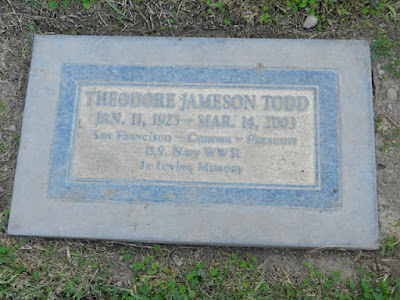Photos by Betty Todd, Lee Spangler,
Sheryl Todd, and Kathy Rodriguez
This is my dad and me in 1949 when he was 25.
He lived to the age of 80, which would have surprised him very much if he'd known that in his younger years. He expected to die around 55 or 60; his father died at the age of 55. Lois was my dad's second wife, and they moved to Prescott, Arizona, a number of years after their respective divorces and their marriage to each other. She died in 2010 in California, and her ashes will be brought to Arizona to be with his. This is what they wanted, although it's far away from either family. This is an older photo and I don't know what the marker looks like today.
The blossoms, the blue fountain and the tree are nice, although this stark setting at the Prescott United Methodist Church makes me sad.
I like the view of the hills. However, once again the spot seems so barren. I saw a photo of the old Methodist Church which was of a nice style, substantial and attractive with architectural merit. I'm not even showing you a picture of the church here. It might have seemed modern in some context, but I don't like it.
My sister and brother and I decided to buy a stone for our dad and put it in the family plot in Corona, California, at Sunnyslope Cemetery where my dad's ancestors and relatives have been buried since the 1890s.

Here is what we got. It's really hard deciding what to put on a stone, and it's the first time I had had to take part in this decision. As a historian I wanted something more than simple dates. Although he lived in Larchmont, New York, for awhile as a child and for a short time in Bisbee, Arizona, we settled on these three locations. He was born in San Francisco, lived most of his life in Corona, and then moved to Prescott. We wanted to give some hint of where he spent his last years, because he loved his life in Prescott and his ashes are there. I'm sure that someone will be confused by the fact that he has a stone here in Corona, but it was more important to us to have a place for him among his family and, at least as importantly, where future generations could find him in their family history. We wanted to honor his service in the war, and then … what do you say to express your feelings about losing your dad? "In Loving Memory" had previously seemed trite to me because you see it often, but it was only when trying to figure out what to put on the stone that I realized why people use it. It meant everything to me at that moment, and no one else had to understand.
And here I make a confession: Why three locations - not two, not four? You could say they fit on the stone, and they do. But equally, I have always loved the sound of the way James Joyce ended his mammoth novel
Ulysses: "
TRIESTE, ZURICH, PARIS. 1914-1922." Three little words and a span of years give a sense of breadth and movement. So, too, I hoped, our marker. My father was not the last in a line that loved to travel, to experience new sights and cultures, and was fortunate enough to be able to go beyond San Francisco, Corona, and Prescott, and see a good-sized part of the world.
My sister and Mom went to the cemetery to take the photo I've been talking about, and the bird of paradise flowers are from my mother's garden. I thought it was sweet, as my parents had been divorced for about 23 years.
In February of 2011, I came back to take some pictures. The management at the cemetery explained that due to severe flooding some months or so in the past, many of the stones were encrusted with mud. This is my dad's father. You'll be able to read the stone later in the post.
And this is my dad's mother. You can read it here, but you'll be able to read it better in a minute.
Here is Thorndike C. Jameson, Carol's father. I hardly know what to say about the disrespectful condition of this stone and the thoughtless tire tracks.
Lee asked the cemetery manager if they had some pumice he could borrow to clean up a bit. For those who don't know, he is not even a family member; he was doing this for me. The manager wouldn't loan a traveler theirs, but said it could be gotten at some big box store and waved vaguely in that direction. Lee noticed two members of the grounds crew working on some equally-lime-coated stones nearby and began chatting. They were very friendly, loaned him a pumice stone, and said to leave it on the fender of a backhoe when he was done.
Here's what my dad's stone looked like by the time Lee left, much tired from wrestling with the lime.
He had also scrubbed a number of other ones. My grandmother's stone cleaned up partially as well. You can certainly read it now.
And my grandfather's stone looks very good in the bright light even though remnants of the flood remain.
///\\\///\\\////\\\///\\\///\\\///\\\///\\\///\\\///\\\
Thanks, Julie, for giving me the excuse to collage together a story and some memories.
This blog is sponsored by Tapir and Friends Animal Store.








.jpg)










